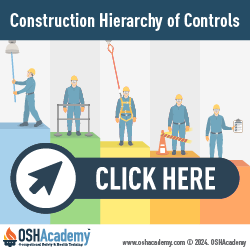Controlling Exposure and Behaviors
It's important to understand that all fall hazards can be eliminated, prevented, or controlled, especially when a combination of methods are used.
Controlling exposure to hazards in the workplace, no matter what the situation, is generally done using a strategy called the "Hierarchy of Controls" (HOC). We have developed a modified fall prevention HOC model for construction that combines the recommendations in ANSI/ASSP Z359.2, Minimum Requirements for a Comprehensive Managed Fall Protection Program, ANSI/ASSP Z10, Occupational Health and Safety Management Systems, and OSHA's Hierarchy of Controls.
Exposure Controls
Exposure controls focus on strategies and methods to prevent or control exposure to fall hazards. If used alone, exposure controls are not as reliable because workers don't know why they are important. Click on the button to see information on the methods used to control exposure.
- Elimination/Prevention: For example, eliminate a hazard by lowering the work surface to ground level, or move a process, sequence or procedure to a different location so that workers no longer need to approach a fall hazard. Elimination is most effective because if you can remove the hazard, you also eliminate the exposure.
- Passive fall protection: Barriers such as guardrails, covers over exposed floor openings, and safety nets are used to isolate or separate the fall hazard from the worker.
- Active fall protection: These controls actively prevent access to fall or, if a fall occurs, limit the distance of the fall.
- Travel restraint systems: Positioning and restraint equipment such as full-body harnesses and lanyards tied to anchors of lifelines can keep the worker away from a ledge or other fall hazard.
- Fall arrest systems: Fall protection equipment such as fall-arrest systems and safety nets are used to prevent injury should a fall occur.
Behavioral Controls
Behavioral controls focus on controlling worker behaviors to prevent falls. If used alone, behavioral controls are not as reliable as exposure controls. Click on the button to see information on the methods used to control behaviors.
- Warnings: Warnings are used to raise awareness of fall hazards. Warning tape and cones are common types of warning.
- Administrative controls: These methods do not focus on controlling exposure to hazards, but on controlling workers behaviors. Administrative controls are last on the hierarchy of controls because they rely on worker compliance for success. And as we know, any system that relies on human behavior is inherently unreliable.
It’s important to understand that the first priority is to eliminate the hazard. Never work at elevation if you don't have to. Doing so may not prevent a fall, but it will likely decrease both the probability and severity of the injury.
It's important to understand that the first priority is to eliminate the hazard Never work at elevation if you don't have to. Doing so may not prevent a fall, but it will likely decrease both the probability and severity of the injury.
Knowledge Check Choose the best answer for the question.
3-8. Which of the following would totally eliminate exposure to a fall hazard?
You forgot to answer the question!

